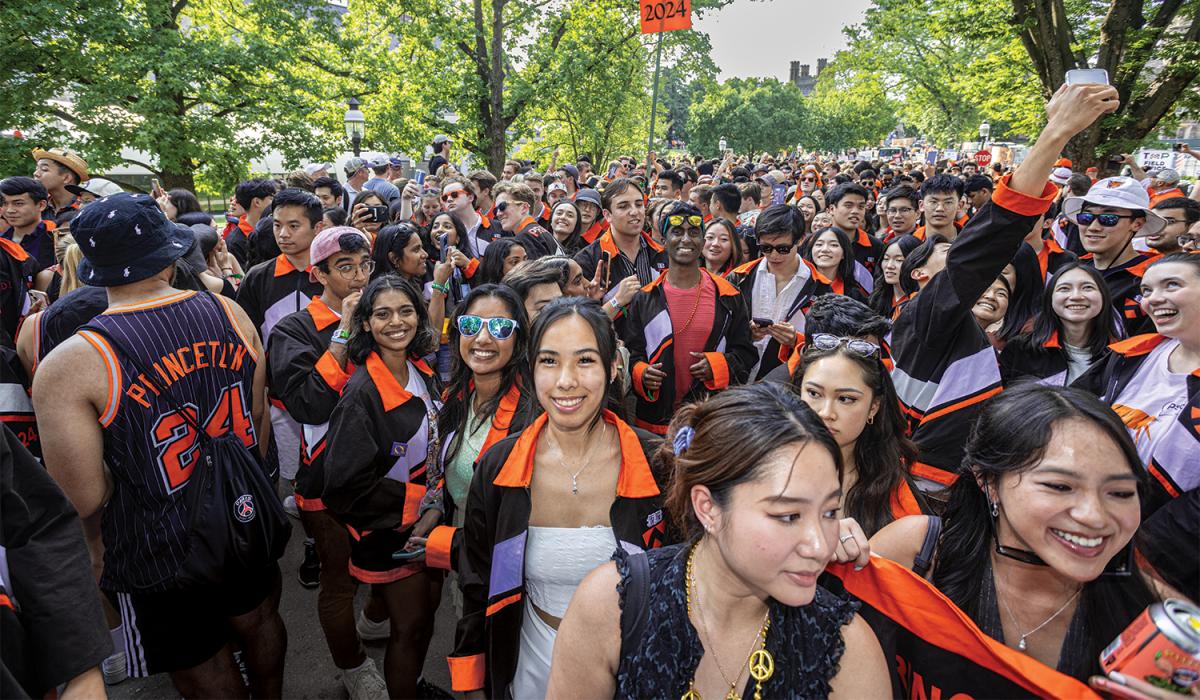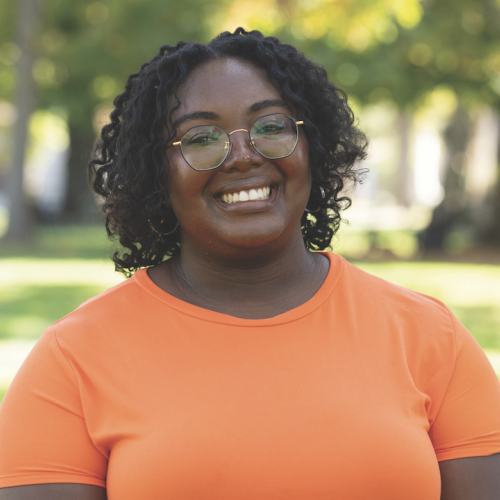Hours before the P-rade on Saturday at Reunions, word began circulating that Princeton’s oldest-ever alum, Joe Schein ’37, had died Friday morning at age 109. Schein had become a fixture at Reunions, kicking off the P-rade while carrying the Class of 1923 Cane since 2016. That first year at age 101, Schein walked the entire P-rade route and continued to do so throughout most of his reign.
His love and dedication to Princeton will forever be cemented, as his family buried Schein in his class jacket, his Einstein baseball cap that reads “E=mc²,” and a Princeton tie. Schein offered a final message to Princetonians through an Instagram video shared by the University on Friday.
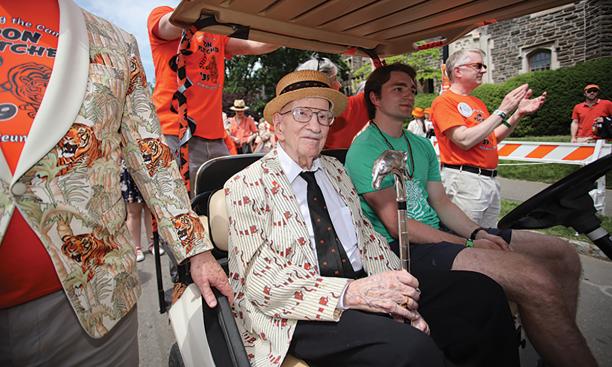
“I wish you a very happy reunion and I wish you all the good fortune that life can bring if you are prepared for it, as you certainly have been at Princeton,” he said. “Go Tigers!”
A day later, Don Fletcher ’39 *51, 105, took the Class of 1923 Cane and started the P-rade. As reuners made their way down Elm Drive, pro-Palestinian protesters rushed into the middle of the road and temporarily blocked the festivities. Security intervened, causing protesters to clear the road. The disruption lasted about two minutes.
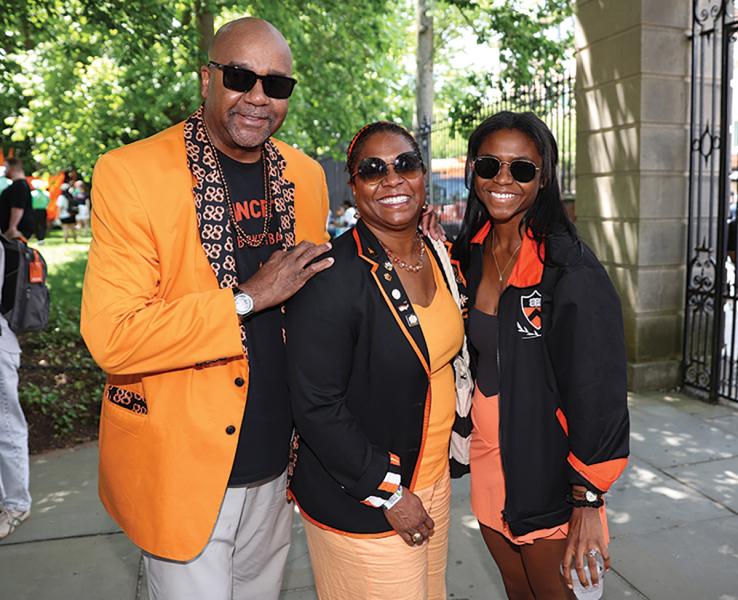
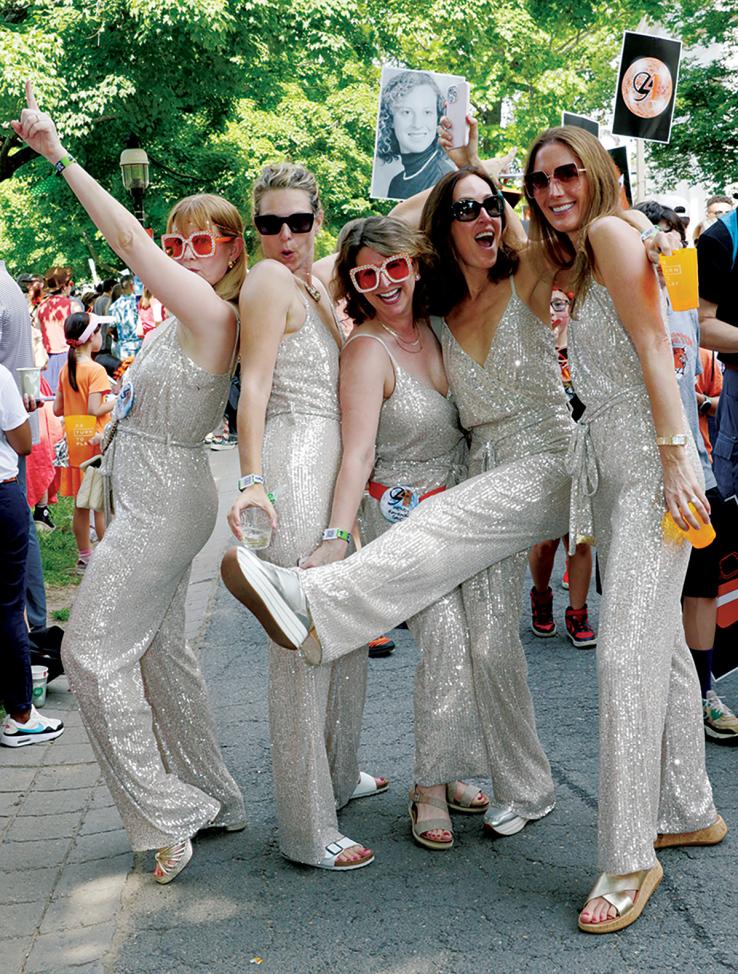
The protesters — which included a mix of grad and undergrad students, alumni, faculty, and people from the area and beyond — began chanting alongside the path near the Class of 2019 and 2020 staging areas and the P-rade continued without further incident. The group, which goes by Princeton Israeli Apartheid Divest (PIAD), grew to more than 100 protesters throughout the P-rade. They handed out cards and Palestinian flags, and asked alumni to sign their pledge to withhold donations from the University until it meets the group’s divestment demands. The pledge had 1,044 signatures as of June 14.
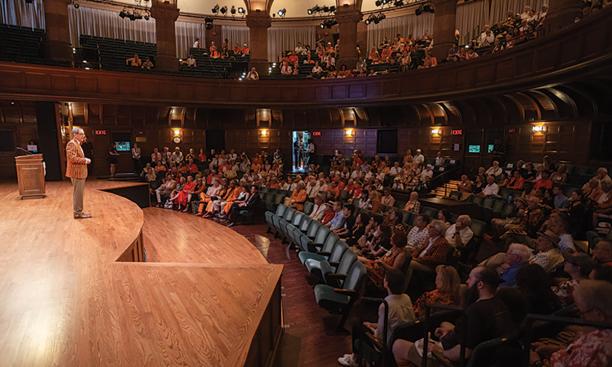

“The movement will keep building and growing into the summer and into the fall,” said Sarah Sakha ’18, who has been to campus a handful of times in the past few months to join the protest. “We’ll keep supporting students on campus and faculty as they continue the movement advancing toward their demands.”
Reactions were mixed: Some alumni cheered and high-fived the protesters while others voiced their disapproval — verbally and with hand gestures. One marcher threw his drink at the protesters. But largely the sea of paraders sporting orange and black tiger stripes proceeded as usual, with marching bands and music from floats often drowning out the chants.
Protesters disrupted the weekend a few other times, as PIAD wrote on social media on Friday, “This weekend, act, disrupt, and escalate on your own terms — all tactics welcome.” The next morning, the words “pretty town bloody gown” appeared in spray paint across the white columns of Robertson Hall and the water in Princeton’s Fountain of Freedom had been dyed red.
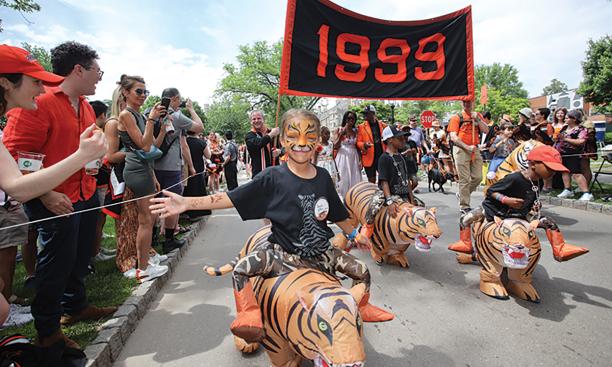
The protesters also interrupted President Christopher Eisgruber ’83’s annual Q&A later that morning in Alexander Hall’s Richardson Auditorium. About 20 minutes in, local resident Joline Konson stood up and began shouting and was eventually escorted out by Public Safety officers after ignoring an initial warning. As a video began to play on the stage as part of Eisgruber’s presentation, about 50 people in the audience silently held up their red hands while still sitting.
As Konson was being taken out, the protesters with red hands began to chant and marched out of the auditorium. Throughout the roughly seven-minute disruption, several alums in the audience shouted “Shame” and “Let him talk” at the protesters. After the protesters left, several small wireless speakers apparently left under seats went off at intervals with pro-Palestinian messages. At least three were confiscated. The protesters continued to chant outside of Richardson.
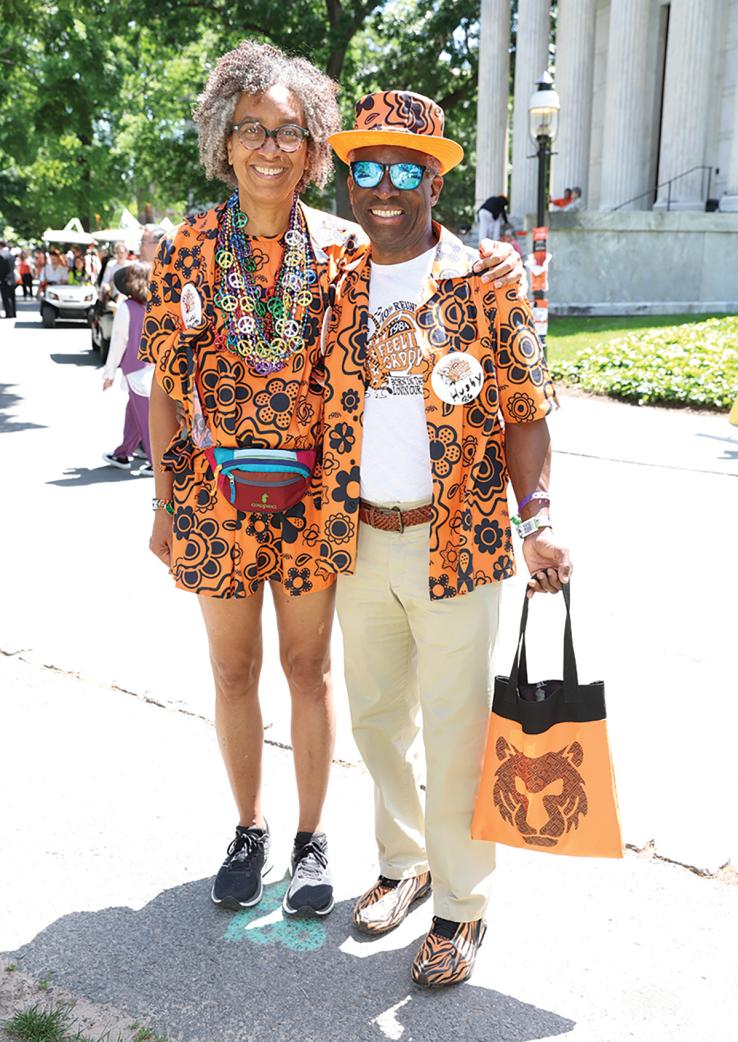
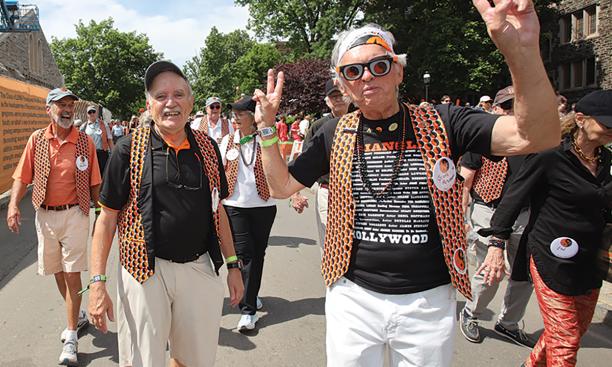
Ken Mayers ’58, who was wearing a pro-divestment T-shirt and a keffiyeh around his shoulders, said he had walked out with the students “because I think the University has failed to negotiate with the protesters, who have a perfectly valid argument.” Mayers said he supported the walkout but not the protester who shouted during Eisgruber’s talk. “I didn’t think it was appropriate to stand up shouting,” he said.
“I respect that there’s a point of view, [but] I don’t approve of the tactics,” said Bob Auray ’73. He added, “I’d have more respect for these folks if they’d go over and fight.”
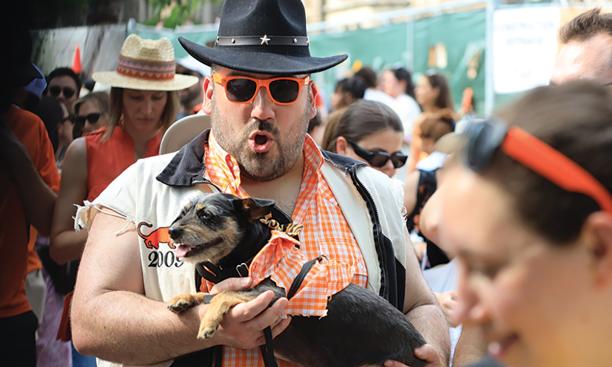

After the protesters walked out, Eisgruber addressed the audience, saying, “Protest is OK, disruption is not.” He later fielded questions from the audience, including one from an alumnus who praised Princeton for its handling of protests on campus and said that other universities had “made fools of themselves.”
Eisgruber quickly defended the leaders of peer institutions, saying they may be facing different challenges. “If you’re in an urban center, you have a lot more people coming onto your campus who may not be part of your community and share its values at all,” he said. “I appreciate very much your support, and I just hope that at what is a very difficult time you will also lend that support and bit of grace to campuses that are struggling beyond what we are doing. Because we need those peers — they are an important part of America and an important part of the higher-education system.”
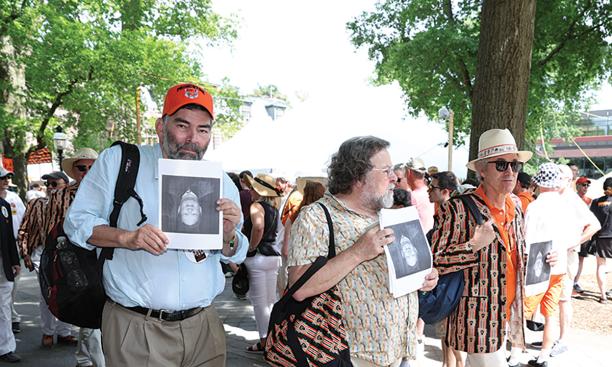
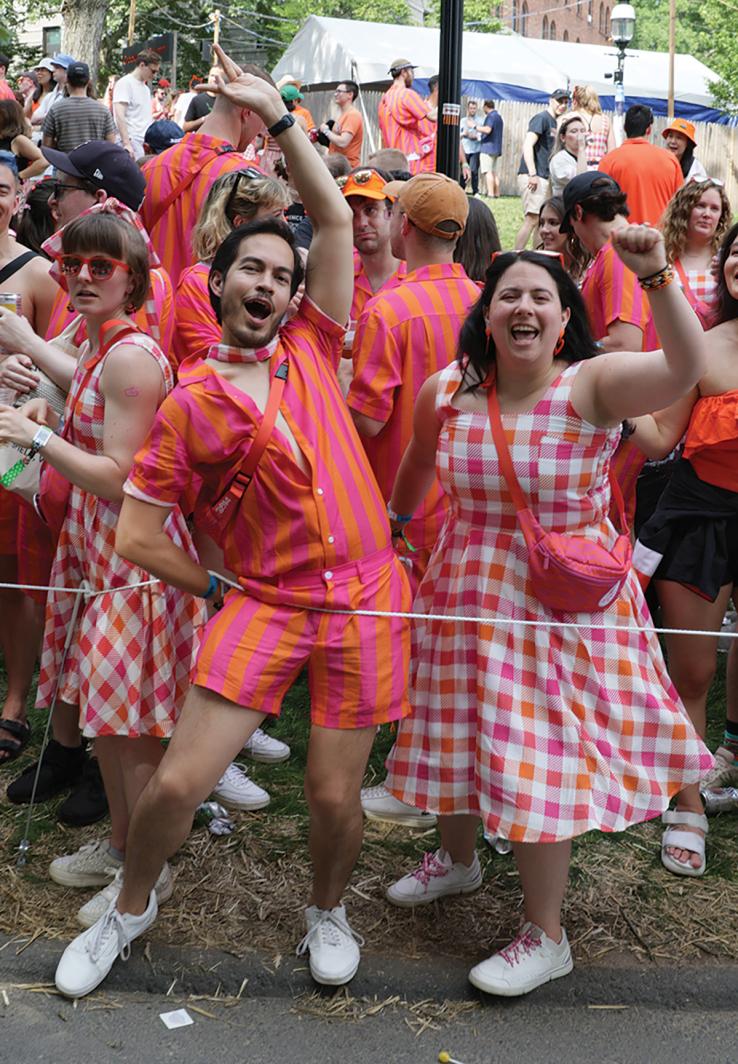
The session also included a moment of levity when Mike Salmanson ’82, who’d attended law school with Eisgruber and his wife, Lori Martin, at the University of Chicago, stood up to ask a question. Eisgruber told a story about auditioning for the law school musical, in part to spend time with his future wife.
“So Lori did not get cast in the musical — I did!” Eisgruber said. “Mike Salmanson was the director of that musical, and I can remember Mike’s instructions to me, which were, during all the dance numbers, stand in the back and lip sync.”
While some reported other encounters with protesters, including H. Clay McEldowney ’69, who said about 30 chanting protesters entered his class’s headquarters at Scully on Friday, many alumni told PAW they were unaware of the incidents. Indeed, for a large majority of the roughly 25,000 alumni, family, guests, faculty, staff, and graduating seniors, Reunions 2024 was celebrated as usual, under warm and sunny skies.
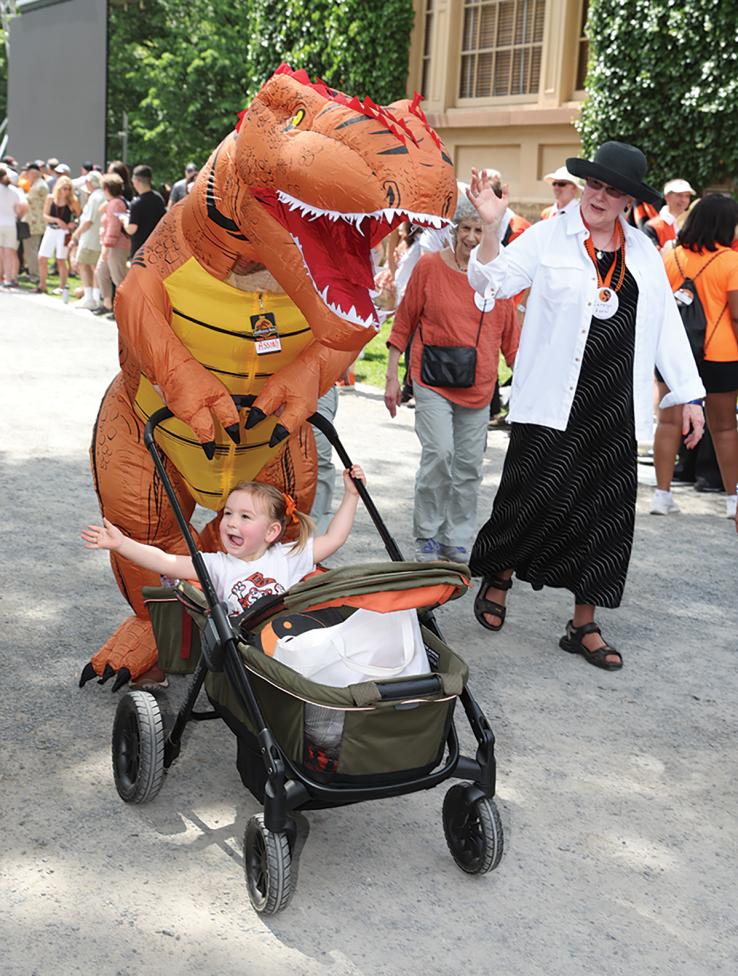
There were alumni in inflatable tiger and dinosaur costumes, various western attire for the Class of 2009’s rodeo theme, as well as the Class of 2014’s bright and clashing pink-and-orange-striped outfits as part of their Malibu 10 theme, a nod to Barbie.
For the Class of 2024, Reunions marked a particularly joyous occasion, as one of their final chapters of a turbulent four years on campus. They began their Princeton journey in the thick of the pandemic, taking their first classes remotely during the fall of 2020 and enduring a strange socially distant return in the spring — but they rose above. The class marched loudly and proudly as they rounded out the P-rade, donning their class jackets.
Perhaps one of the happiest people at this year’s festivities was Marissa Hart ’24, who was celebrating her birthday. “It’s a party all around campus, so it’s the best way to celebrate,” she said. Amid all the orange and black, Hart, who had a gold “It’s my birthday” sash and three big balloons, was hard to miss. “I just love Princeton and I’m happy to be here for my birthday!”
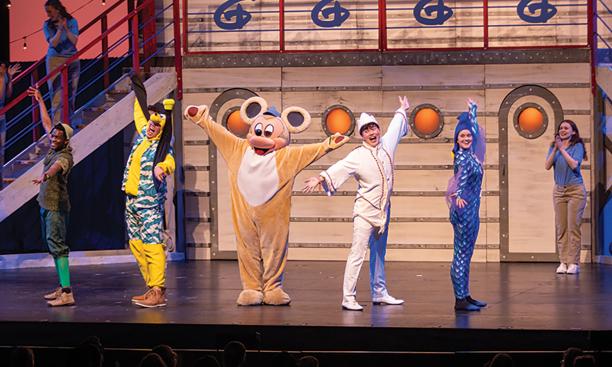
Throughout the weekend, alumni partied under the tents, reconnected over meals, dove into a variety of topics at more than a dozen Alumni-Faculty Forums, and made memories at many other events and gatherings.
The ripple effects of the Oct. 7 terrorist attack and the ongoing Israel-Hamas war were discussed in a handful of panels. On Friday, a packed room of more than 50 mostly Jewish alumni met at the Chabad House for a panel titled “Crisis for Israel, Crisis for American Jews: What’s Next?” The hour-long discussion moderated by Rabbi Eitan Webb with panelists Owen Alterman ’99, Ilya Shapiro ’99, and Leah Powell ’26 covered the climate for Jewish students on campus, views on the situation abroad, and ways the alumni community can help, among other topics.
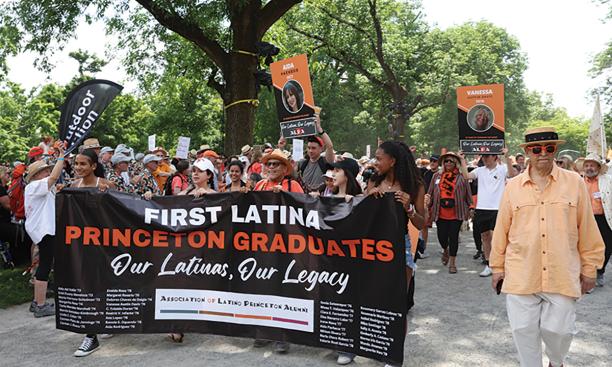
“I shouldn’t feel distressed walking through campus,” said Powell, vice president of the Chabad Student Board. She explained that some of the protesters’ chants are offensive and that she’s been discouraged by the University’s response.
Despite this, Alterman, a senior correspondent for Tel Aviv-based outlet i24 News, said the strengthened connection between the Jewish community has been one silver lining. “This is the ultimate stress test,” he said, adding it’s been “an incredible positive surprise that really should give us a lot of strength going forward.”
In a related conversation Saturday, Professor Keith Whittington and Jonathan Rauch, a senior fellow at the Brookings Institution, addressed free speech on campuses around the country. Hosted by Princetonians for Free Speech, Rauch began the conversation by quoting a portion of Whittington’s 2018 book Speak Freely in which he stated campuses are not yet in crisis and asked Whittington if his feelings have changed since then. “I think we’re doing worse,” Whittington said.
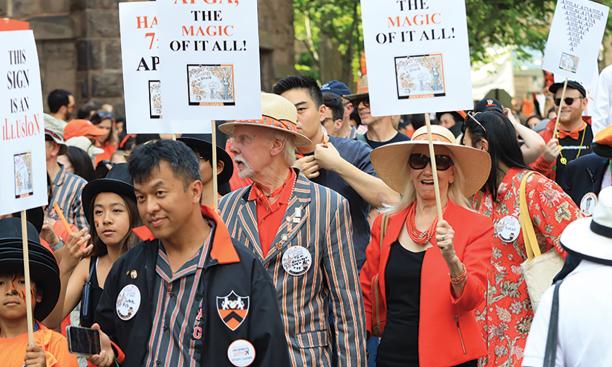
“Part of my concern is that the problems that we see are in some ways the surface problems related to free speech and academic freedom, and below that surface are potentially much deeper problems,” he continued.
At an Alumni-Faculty Forum on civility and finding common ground in U.S. politics, Arthur J. Ewenczyk ’09, chief counsel of the House Committee on Oversight and Accountability, said that citizen engagement is becoming even more important as public discourse challenges the norms of democracy.
“If people have views that are outside the bounds of our democratic understanding, if they are pushing toward authoritarianism, I’m not saying that you spitefully yell at them and shake your fist,” Ewenczyk said. “But there is a duty to engage with people … even if at times that can yield some uncivil behavior, particularly coming back at us.”
Climate change was another popular topic that featured opposing views in two panels on Friday.
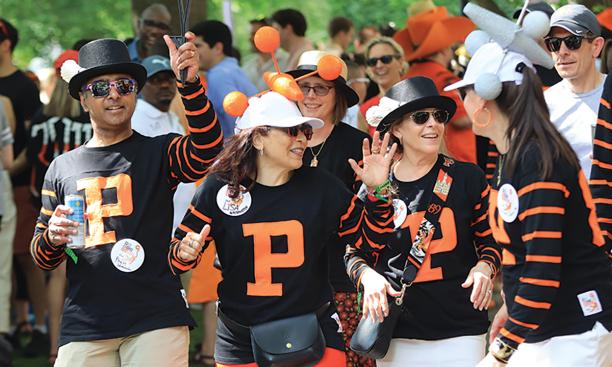
At “America the Beautiful: From Sea to Shining Sea,” sponsored by the Concerned Black Alumni of Princeton, speakers discussed how systemic racism continues to impact the environmental landscape of the United States in a variety of ways, including the geographic location of landfills and incinerators, which have been shown to disproportionally impact communities of color.
“Land is something that cannot be moved, and when we think about the ways in which the colonial system treated land, it has always been a racialized concept,” said Kevon Rhiney, a visiting professor in the environment and the humanities at the High Meadows Environmental Institute.
Moderator Ariel Rogers ’08, a visiting instructor at Dominican University, said the interstate highway system and redlining pushed people of color “literally downhill, where the waste from day-to-day life would flow and trickle,” which led to the destruction and separation of communities, with ripple effects such as the creation of food deserts and increased health concerns.
That afternoon, the Conservative Princeton Association hosted “The Great Escape from Net Zero Hunger Games,” where speakers discussed the opportunities for Africa’s energy and agricultural potential and claimed to debunk climate change “myths.” For example, Diana Furchtgott-Roth, director of the Center for Energy, Climate, and Environment at the Heritage Foundation, a conservative think tank, said “most sea-level rise is a response to the interglacial period,” and not caused by human-induced climate change, though there is broad consensus within the scientific community, including at Princeton, that human-caused global warming is the cause of the current rise of global sea levels.
Lindianne Sappington ’76, executive director of Snake River Music Gardens, a nonprofit focused on rural farming, spoke about how American agricultural regulations implemented to mitigate climate change concerns can hurt farmers. “Most food-producing families are too polite to say how we feel about what’s being done to us,” Sappington said, but ultimately, “If we don’t grow food, you don’t eat.”
The speakers were questioned by a couple of members of the audience, and one person, who shouted over the presenters as they attempted to respond to his questions, was ultimately asked to stop speaking and left the room.
A number of exhibits spearheaded by alumni were also on display throughout the weekend, including The Princetoniana Pin Collection at Maclean House and the 150 Years of Asian and Asian American Students at Princeton installation at Frist Campus Center.

At the Lewis Center for the Arts, reuners were invited to view the latest iteration of Diana Weymar ’91’s Interwoven Stories, a years-long collaborative sewing art project that most recently solicited contributions about what it means to heal with music, which tied into Princeton University Concerts’ Healing with Music series. Weymar’s project started in 2016 at the Arts Council of Princeton and has since gone on to Bogotá, Colombia; Belfast, Northern Ireland; and British Columbia, to name just a few places. At a PUC reception on Thursday afternoon, Weymar said the project’s return to Princeton was “really kind of magical.”
“Each of these stories reflects the therapeutic process of being still, and making something, and being together,” Weymar said of the stitched pieces, which ranged from a simulated postcard offering greetings from Princeton to a quote by Jon Batiste surrounded by pink flowers and yellow butterflies to a Princeton-themed word search puzzle.
The weekend ended with the annual fireworks show held in Princeton Stadium, a handful of alumni arch sings, plus more drinking and dancing under the stars into the early hours of Sunday morning.
Jen Caudle ’99, a regular at Reunions, said the event seems to get better each year. While she participated in “a little of everything,” her favorite part was connecting with new people and developing new relationships that she missed out on as an undergraduate.
“Princeton Reunions is the ultimate example and epitome of school spirit and community,” she said. “It’s just so neat to see how tight of a community we are and how much Princeton means to all of us.”

